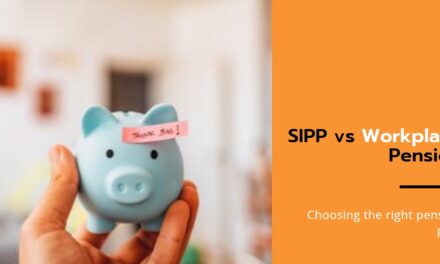In this comprehensive guide, we’ll discuss everything you need to know about SIPP retirement planning.
SIPPs (Self-Invested Personal Pensions) can be a fantastic way to save for your retirement, but it’s essential to understand the ins and outs to make the most of them.
- How to Invest Your SIPP for Retirement
- SIPP Retirement Planning Basics
- How Much Do I Need in a SIPP to Retire?
- Tips on Planning for Retirement
- How Do I Avoid Paying Tax on My SIPP?
- Are SIPPs Free of Inheritance Tax?
- Can a SIPP Be Left in a Will?
- Can I Take All My SIPP as a Lump Sum?
- How Many Funds Should I Invest My SIPP In?
- Is It Better to Pay into a SIPP or an ISA?
- Can You Have 2 SIPP Pensions?
- Can I Still Pay into My SIPP After Retirement?
- Can I Retire at 60 with £300K in a SIPP?
- Can You Retire at 55 with £1 Million Pounds?
- Can I Retire at 55 with £300K?
- Is a SIPP Pension a Good Idea?
- What Are the Disadvantages of a SIPP Pension?
How to Invest Your SIPP for Retirement
Investing your SIPP for retirement involves selecting a variety of investment options that suit your risk appetite, financial goals, and timeframe.
When building your SIPP portfolio, you should consider diversifying across different asset classes, including funds, bonds, property, ready-made portfolios, cash and other investments in your retirement.
A balanced portfolio can reduce risk and help you achieve your retirement goals.
Here’s a table summarising some popular SIPP investments and their pros and cons.
| Investment Type | What is it? | Pros | Cons |
| Stocks and Shares | Ownership in individual companies | Potential for high returns, growth | Risk of losing money, market ups and downs |
| Funds | Collection of stocks, bonds, or other investments | Spreads risk, professional management | Fees, and performance depends on the fund manager |
| Investment Trusts | Closed-ended funds that invest in various assets | Spreads risk, potential for income/growth | Fees, and prices can be above or below asset value |
| ETFs and Index Funds | Funds that track a market index | Low fees, spreads risk, easy to buy/sell | Tied to overall market performance |
| Ready-made SIPP Portfolios | Pre-selected mix of investments for your SIPP | Easy to start, diversified, low effort | Less control, performance depends on selection |
| Managed SIPP Portfolios | Investments chosen by a professional manager | Expert management, tailored to your goals | Higher fees, depends on manager’s performance |
| Property | Real estate investments, e.g., commercial property | Spreads risk, potential income, inflation hedge | Less liquidity, tied to property market |
For example, John, a 45-year-old SIPP investor, might have a higher risk tolerance and a longer investment horizon. He could allocate more of his SIPP funds to stocks and alternative investments, while Sally, a 60-year-old investor, may prefer a more conservative approach with a focus on bonds and cash holdings.
If you’re unsure, choosing a ready-made SIPP portfolio tailored to your risk profile is a popular option, but it will be more expensive than picking your own investments.
Alternatively, financial advice is the next step up – it’s more expensive again, but you’ll get tailored advice to your circumstances and goals.
SIPP Retirement Planning Basics
Planning your retirement around your SIPP involves setting clear financial objectives and assessing your current financial situation. Here are some steps to help you plan your retirement:
- Estimate your desired annual income during retirement. Consider factors such as living expenses, healthcare costs, and lifestyle preferences.
- Check your current SIPP balance and evaluate its growth potential based on your current contributions and investment strategy.
- Identify any shortfall between your projected SIPP balance and your retirement income goals.
- Increase your SIPP contributions if needed to bridge the gap between your current balance and your retirement income goals.
- Regularly review and adjust your SIPP investment strategy based on your evolving retirement objectives and market conditions.
How Much Do I Need in a SIPP to Retire?
The amount you need in your SIPP to retire depends on various factors, including your desired retirement income, other sources of income (e.g., state pension, rental income), and your anticipated retirement expenses.
A popular rule of thumb is to aim for an annual retirement income equivalent to 70% of your pre-retirement salary. For example, if you earn £50,000 a year, you might want to target a retirement income of £35,000 per year.
As to when you can afford to start taking that income – again, it depends on your retirement goals and lifestyle. However, a commonly used rule of thumb in the pensions world is the 4% rule.
The 4% rule means taking 4% of your pension each year as your retirement income (you can top this up with any other income like your state pension if applicable).
Taking 4% of your SIPP each year means it will roughly last for 25 years, not accounting for investment fluctuations or inflation.
This could take you from the age of 65 up to 90, for example.
It is by no means an exact science, but it can help give you a rough idea of how much you’ll need in your SIPP or collective wealth to fund your desired retirement lifestyle.
You might also be able to leverage other financial tools, like equity release, to support your retirement. A financial advisor can get a holistic understanding of your finances and tailor a financial plan specific to your needs.
Tips on Planning for Retirement
Here are some useful tips to help you plan for your retirement:
Start saving early
The sooner you begin contributing to your SIPP, the more time your investments have to grow.
Regularly review your SIPP
Periodically assess your SIPP’s performance and make adjustments to your investment strategy as needed.
Diversify your investments
Diversify your SIPP portfolio to spread risk and potentially increase your returns.
Consider professional advice
Seek professional financial advice to help you create a tailored retirement plan based on your specific needs and goals.
Stay informed
Stay up-to-date with changes in pension regulations and investment options to make well-informed decisions about your retirement.
How Do I Avoid Paying Tax on My SIPP?
While it’s not possible to completely avoid paying tax on your SIPP, you can minimise your tax liabilities by following these strategies:
- Each tax year, you have a personal allowance, which is the amount of income you can earn before paying income tax. For the 2021/22 tax year, this is £12,570. You can structure your pension withdrawals to stay within this limit.
- When you start drawing from your SIPP, you can take up to 25% of your pension pot tax-free. The remaining 75% is subject to income tax at your marginal rate.
- By spreading your SIPP withdrawals over several years, you can minimise your income tax liability by staying within lower tax brackets.
- You might also want to explore additional tax-efficient investment options, such as ISAs and Lifetime ISAs, to diversify your retirement income sources and reduce tax liabilities.
Are SIPPs Free of Inheritance Tax?
Generally, SIPP pensions are not subject to inheritance tax (IHT) if you die before the age of 75.
Your beneficiaries can inherit your SIPP tax-free, provided they take the funds within two years of your death. If you die after the age of 75, your beneficiaries will pay income tax at their marginal rate on any withdrawals they make from the inherited SIPP.
Can a SIPP Be Left in a Will?
You can nominate one or more beneficiaries to inherit your SIPP upon your death. This can be done by completing a beneficiary nomination form or an expression of wish form provided by your SIPP provider. You can update your beneficiaries at any time and allocate specific percentages.
Can I Take All My SIPP as a Lump Sum?
Yes, you can take your entire SIPP as a lump sum, but doing so can have significant tax implications.
Only the first 25% of your SIPP is tax-free, while the remaining 75% is subject to income tax at your marginal rate.
Taking your entire SIPP as a lump sum may push you into a higher tax bracket for that year, resulting in a substantial tax bill.
How Many Funds Should I Invest My SIPP In?
There is no specific number of funds you should invest your SIPP in, as this depends on your individual circumstances and investment goals.
However, diversification is key to reducing risk and achieving stable returns. Consider investing in a mix of funds, including equities, bonds, property, and cash, to create a well-rounded portfolio.
Make sure the funds you invest in are of good quality and you’ve researched them well. It could end up being counter-productive if you spread your investments too thinly across hundreds of funds if you aren’t being diligent about the quality of these investments.
A financial advisor is typically the safest way to ensure you’re making the right call for your SIPP.
Is It Better to Pay into a SIPP or an ISA?
Whether a SIPP or an ISA is better for you depends on your financial goals and tax situation.
SIPPs offer tax relief on contributions and the potential for tax-free growth but are subject to income tax upon withdrawal. ISAs, on the other hand, do not provide tax relief on contributions but offer tax-free growth and withdrawals.
Can You Have 2 SIPP Pensions?
Yes, you can have multiple SIPP pensions.
There is no limit to the number of SIPPs you can hold, but be mindful of the annual allowance for pension contributions, which is currently £60,000 or 100% of your relevant earnings, whichever is lower.
It can also get tricky to keep track of all your pensions if you have multiple SIPPs dotted around with different providers, so consolidating them might be preferential.
Can I Still Pay into My SIPP After Retirement?
Yes, you can continue to pay into your SIPP after retirement.
You can contribute to your SIPP until the age of 75 and still receive tax relief on your contributions.
However, once you start drawing from your SIPP, your annual allowance may be reduced to £10,000 under the Money Purchase Annual Allowance (MPAA) rules.
Can I Retire at 60 with £300K in a SIPP?
Whether you can retire at 60 with £300,000 in a SIPP depends on your desired retirement income, other sources of income, and expected retirement expenses.
Using the 4% withdrawal rule, you could potentially withdraw £12,000 per year from a £300,000 SIPP. If this amount, combined with other income sources (e.g., state pension, rental income), is sufficient to cover your retirement expenses, then retiring at 60 with £300K in a SIPP could be possible.
Can You Retire at 55 with £1 Million Pounds?
Retiring at 55 with £1 million in your pension pot is achievable if your desired retirement income and expected expenses align with this amount.
Following the 4% withdrawal rule, you could potentially withdraw £40,000 per year from a £1 million pension pot. If this income, along with other sources (e.g., state pension, rental income), is sufficient to cover your retirement expenses, then retiring at 55 with £1 million is feasible.
Can I Retire at 55 with £300K?
Retiring at 55 with £300,000 in your pension pot may be challenging, depending on your desired retirement income and expected expenses.
Using the 4% withdrawal rule, you could potentially withdraw £12,000 per year from a £300,000 pension pot. If this amount, combined with other income sources (e.g., state pension, rental income), is enough to cover your retirement expenses, then retiring at 55 with £300K could be possible. However, you may need to adjust your lifestyle expectations or explore additional income sources to make this work.
Is a SIPP Pension a Good Idea?
A SIPP pension can be a good idea for those looking for greater control over their pension investments and a wider range of investment choices. SIPPs offer tax relief on contributions and tax-free growth but are subject to income tax upon withdrawal.
If you are comfortable making investment decisions and can commit to managing your pension portfolio, a SIPP could be a suitable option for you.
What Are the Disadvantages of a SIPP Pension?
Despite the potential benefits of SIPPs, there are some disadvantages to consider:
- SIPPs often have higher fees compared to other pension plans, such as workplace pensions or stakeholder pensions.
- With a SIPP, you are responsible for managing your investments, which means that poor investment choices can negatively impact your retirement savings.
- Managing a SIPP requires time and effort to research and select suitable investments, monitor performance, and make adjustments as needed.




